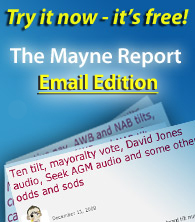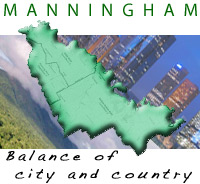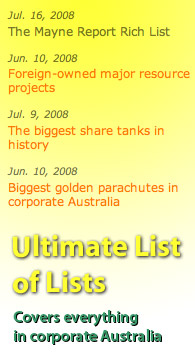Every project that has Chinese investment
December 18, 2022
This list tracks every Australian project which are backed by the Chinese.
Aurukun: the $3 billion bauxite project was to be developed by Chalco. In September 2007 Queensland government awarded the rights to develop the project, but Noel Pearson loudly complained about the dealings with the local indigenous community. Fast forward 15 years and the project was owned by Glencore with Japanese giant Mitsubishi reportedly buying 30%.
Avesbury: nickel mine on Tasmania's west coast which China's MinMetals bought with the bargain basement $US1.2 billion Oz Minerals buy. However, operations ceased in 2008 and only resumed in 2022 under the ownership of Mallee Resources, which was formally known as Myanmar Metals. See 2021-22 annual report.
Balmoral South Project: Shougang Corp agreeing to fund the
development of the project to the tune of $US2.1 billion. Also bought 20 per cent of Prosperity Resources, spent
$400 million buying 20 per cent of WA iron ore company Mt Gibson Iron in early
2008 and spent $56 million in March 2007 buying 13% or iron ore
developer Australian Resources. Ultimately, BalmoralbSouth still hasn't been developed and is 100% owned by Clive Palmer's Mineralogy outfit.
Blair Athol:
one of Australia's largest export thermal coal mines in Queensland's
rich Bowen Basin which produces 9% of all coal used in Japanese power
generation. Operated by Rio Tinto which owns 71.2%, Unisuper has 15%, Japan Coal Development Australia 10.4% and 3.4% is with J-Power,
which operates 67 power stations in Japan. It was produces 11 million
tonnes a year until Rio Tinto ceased mining in 2012. It was briefly owned by Linc Energy before Terracom bought the asset in 2017 and recommenced mining. Terracom finished 2022 with a market cap of around $700m. Blair Athol exported 2.3m tonnes of coal in 2021-22.
Bowen Basin coal tenements: Xinwen Mining agreed to pay
a staggering $1.5 billion for Linc Energy's tenements
in Queensland but this turned into one of those "Chinese deals" which
wasn't as binding as you'd think. See farcical ASX announcement at the time.
Brockman/Nammuldi:
located about 60 km north-west of Tom Price in the Pilbara and 100% Rio
Tinto owned. Was slated for Chinalco to take a direct 15% and left its
Rio Tinto stake to 18% but this fell over so Chinalco only owns 9%
through Rio Tinto. First opened in 1992 and then re-opened after a
major upgrade in 2003. Annual production of 8 million tonnes worth more
than $1 billion and WA lifted the royalty rate from 3.75% to 5.62%
in 2010.
Bungalow Iron Ore Project: Baotou Iron & Steel
agreed to invest up to $40 million for 50% of Centrex
Metals' prospective Bungalow iron ore project in South
Australia.
Cairn Hill copper-gold project: Jilin Tonghua Iron & Steel owns a ten per cent share of IMX Resources which is attempting to develop near Coober Pedy in South Australia, along with other Australian and African projects.
Cape Lambert Iron Ore Project: the China Metallurgical Group
received FIRB approval to buy the Cape Lambert Iron ore project in WA
for $400 million, but then controversially on-sold control to a Russian
company.
Channar: The
coastal Pilbara iron-ore mine has a capacity of 10 million tonnes. Rio
Tinto owns 60% and China Iron and Steel the remaining 40%. Rio Tinto
now only 13% Australian owned and Chinalco owns 9%, so overall Chinese
government ownership 45.4% and overall Australian ownership just 8%.
WA lifted the royalty rate from 3.75% to 5.62%
in 2010.
Eastern Range:
Rio Tinto 54% and Shanghai Baosteel Group Corporation 46%, so overall
Australian ownership is down to about 7%. Chinalco owns 9% of Rio Tinto
so overall Chinese government ownership at 50.8%. Produces 6.5 million
tonnes a year worth more than $700 million a year based on 2008 prices.
At the standard 3.75% rate, WA royalty is more than $25 million a year
and rose in 2010 to 5.62% under new Premier Colin Barnett.
Eyre
Peninsula: Wuhan Iron and Steel would invest $180 million
for a 50% share in five of Centrex Metals' iron ore tenements. It is
Centrex's second major Chinese partner, which is now 25% Chinese-owned.
Golden Grove:
copper and zinc mine in WA which China's MinMetals bought as part of
its bargain basement $US1.2 billion deal to buy most of Oz Minerals in 2009. MinMetals then sold it to Owen Hegarty's private equity firm EMR for $US210m in 2017 and it was then floated as 29Metals in 2021 and it finished 2022 with a market cap of around $1.23 billion. The 6 months to June 30 2022 generated EBITDA of $94m and a maiden 2c dividend.
Gove bauxite mine and alumina refinery:
Alcan's biggest Australian asset is now part of Rio Tinto which is only
13% Australian-owned. The Chinese government currently owns 9% of Rio
Tinto through Chinalco. Located at Nhulunbuy on the Gove Peninsula in
the east Arnhem Land region of the Northern Territory, a $3 billion
expansion has lifted alumina production from 2 million to 3.8 million
tonnes a year, but it only paid about $10 million in royalties to the
government and Aboriginal land owners in 2006-07.
Hail Creek:
a Rio Tinto operated coal mine in Queensland which is currently under
construction and will produce more than 4 million tonnes a year.
Marubeni Coal has 5.33% and Sumisho Coal 2.67%, with Rio Tinto holding
the balance. Rio is only 13% Australian-owned. The Chinese government
currently owns 9% of Rio Tinto through Chinalco. The previous 7%
Queensland royalty has risen to 10% for all coal sold at more than $100
a tonne.
Hope Downs: Rio Tinto's newest iron ore mine in WA which is a
50-50% joint venture with Gina Reinhart's Hancock Prospecting, so the
Chinese government owns 4.5% through its 9% stake in Rio Tinto.
Karara deposit: Anshan Iron & Steel is bankrolling this $1.8 billion iron ore development through Gindalbie Metals which it now owns 38% of after investing $201 million in equity.
Krestel: the old Gordonstone coal mine in Queensland which Rio Tinto renamed after buying out Arco in 1998. Japanese trading house Mitsui has 20%. Currently undergoing a $1.1 billion expansion to extend its life by 20 years but Rio Tinto is only 13% Australian-owned. The Chinese government currently owns 9% of Rio Tinto through Chinalco. The previous 7% Queensland royalty has risen to 10% for all coal sold at more than $100 a tonne.
Lady Annie copper project: China Sci-Tech Holdings, a Hong Kong-based investment company entered into a conditional sale agreement in March 2010, to purchase the mine from Cape Lambert Resources for $135 million.
Marandoo: commissioned in 1994, this 100% Rio Tinto operation is therefore effectively 9% owned by the Chinese government through its direct stake in Rio Tinto. Located about 45km from Tom Price and adjacent to the Karijini National Park. The nominal production capacity of 15 million tonnes is worth more than $1.5 billion based on 2008 prices. Australian ownership is only 13%. The WA government lifted the royalty rate from 3.75% to 5.62% in 2010.
Mesa J: This Pilbara mine is the world's biggest supplier of low grade iron-ore. A massive 50-60 million tonnes is shifted each year which, after processing, translates into about 32 million tonnes of saleable ore, worth more than $2.5 billion. Rio Tinto owns 53%, Mitsui 33%, Nippon Steel 10.5% and Sumitomo Metal 3.5%, so overall Australian ownership is just 7% because Rio is only 13% Australian owned, with Chinalco owning 9% of Rio Tinto and therefore 3.18% of this project. The WA government pockets a 3.75% royalty which is worth about more than $100 million a year and is rose to 5.62% in 2010 under new WA Premier Colin Barnett.
Mt Tom Price: Rio Tinto's oldest operation started production in 1966 and still produces up to 20 million tonnes a year worth more than $2 billion a year on 2008 contract prices. Australian ownership is only 13%. The Chinese government currently owns 9% of Rio Tinto. WA lifted the royalty rate from 3.75% to 5.62% in 2010.
Nammuldi: part of Rio Tinto's Hammersley Iron division in the Pilbara. The Chinese government owns 9% through its direct stake in Rio Tinto which is only about 13% Australian owned.
Oakajee port and rail project: a Yilgarn Consortium group of five Chinese companies will bankroll the $4 billion project in Geraldton. They received $339 million of funding in the 2009 Federal budget and have been given FIRB approval to build.
Paraburdoo: in the Pilbara near the coast and 100% owned by Rio Tinto, which is 9% owned by the Chinese government through Chinalco. Produces 11 million tonnes a year which is worth more than $1 billion based on 2008 prices and standard 5.62% royalty applies.
Ranger: uranium mine in Kakadu operated by ERA, which is 68% owned by Rio Tinto, the London-based company which is only 13% Australian-owned. The Chinese government currently owns 9% of Rio Tinto. Overall Australian ownership about 25% and paid $16 million in royalties in 2006-07, with $2.63 million going to the Northern Territory and $12.37 million to the Aboriginal Benefits Account.
Savage River: one the major projects for Grange Resources which merged with the unlisted and Chinese-controlled Australian Bulk Minerals.
Weipa: the world's biggest bauxite mine at the top of Cape York produces 16 million tonnes a year and is 100% owned by Rio Tinto, meaning it is only 13% Australian-owned. The Chinese government currently owns 9% of Rio Tinto through Chinalco.
West Angelas: The $880 million Pilbara iron ore mine commenced production in 2002 at a rate of 7 million tonnes per annum, but is now up to 25 million, which will be worth more than $2.5 billion in 2008. Rio Tinto owns 53%, Mitsui 33%, Nippon Steel 10.5% and Sumitomo Metal 3.5%, so overall Australian ownership is just 8% but the WA government pockets a 5.62% royalty which should be worth more than $100 million a year.
West Pilbara Iron Ore Project: Baosteel, the Chinese steel giant, invested $286 million reaching a co-operation agreement in August 2009 with WA-based explorer Aquila Resources.
Wheelarra: BHP-Billiton's 12 million tonnes per year iron ore mine located 40kms east of Newman in the Pilbara, WA which is 40% Chinese-owned based on 10% stakes held by Wuhan Iron & Steel, Maanshan Iron & Steel, Jiangsu Shagang and Tangshan Iron & Steel. Normal 5.62% royalty applies.
Yandicoogina: Rio Tinto's biggest Australian iron ore mine in the Pilbara with a recent expansion lifting annual production to 52 million tonnes. Chinalco proposing to buy a direct 15% stake. Produces revenue of more than $5 billion a year for London-based Rio which is now only 13% owned by Australian investors. The Chinese government currently owns 9% of Rio Tinto through Chinalco. The 5.62% annual royalty payment generates more than $220 million a year for WA taxpayers.
Yarwun: aluminium refinery near Gladstone is 100% owned by Rio Tinto, although Chinalco was proposing to buy 50% for $US500 million. Rio is only 13% Australian-owned and the Chinese government through Chinalco currently owns 9%.
CGNPC Uranium Resources: the Chinese state-owned energy group (URC) plans to acquire the Perth-based uranium explorer, Energy Metals. The takeover offer is through a subsidiary, China Uranium Development (CUD) and is worth about $120 million or $1.02 a share.
Chinalco spent $15.5 billion for 9% of Rio Tinto shares in London on February 3, 2008 but was rebuffed in its attempts to pump in another $US20 billion to move to 18% and grab key stakes in numerous mines.
China Nonferrous Metal Mining Co (CNMC): secured a 51.66% shareholding for $252 million of Sydney-based rare earths company Lynas. CNMC also provided a corporate guarantee to a Chinese Bank to raise another $253 million, which brings the cost of transaction to $505 million. They have since been denied the percentage of ownership by a decision by the regulator FIRB which requestedto be cut to less than 50 per cent.
CNOOC: holds a 25% share in China LNG, a new joint venture within the existing $19 billion North West Shelf structure that diluted the other six joint venture parties down to 12.5% each.
China Railway Materials: a Chinese state-owned enterprise, with the group agreeing to take a 12 per cent stake worth $12.6 million, in the junior iron ore explorer, FerrAus, a wannabe iron ore miner in the Pilbara.
China West Mining: Chinese company which also bought 10% or 15 million shares in FerrAus, a wannabe iron ore miner in the Pilbara.
CITIC: paid more than $400 million for its 22.5% stake in the Portland Aluminium Smelter in the 1990s and spent $113 million in July 2007 lifting its stake in Macarthur Coal stake from 11.6% to 19.9%, which is now heavily under-water.
Guangdong Foreign Trade Group: agreed to invest more than $60 million for up to 20% of zinc and nickel miner Kagara in June 2009.
Guangdong Risking Assets Management: agreed to invest $182 million for 20% of Pan Australian Resources at the knock down price of 39.5c a share in May 2009.
Hunan Valin Iron and Steel group: one of China's leading steel mills invested $644.8 million in early 2009 at $2.48-a-share to become the second largest shareholder in Fortescue Metals Group with about 17%. Valin has also agreed to buy iron ore and participate in any future new projects Fortescue undertakes.
Minmetals: the Chinese government's base metals trader offered $US1.206 billion to buy the majority of OZ Minerals' operations including Sepon, Avebury, Rosebury, Golden Grove, Century and Dugald River.
Shenhua Group Corp: China's biggest coal company was lining up for NSW power privatisation and then paid $300 million to the Iemma government in early 2008 for the right to explore for coal on 190 square kilometres near Gunnedah.
Sinosteel: spent $100 million for 10% of WA iron ore hopeful Midwest Corp in early 2008 and then completed a $1.37 billion agreed takeover at $6.37 a share in 2008. Has also bought a minority stake in Murchison Metals, but only has FIRB approval to go to 49%.
Zhongjin Lingnan: China's third largest zinc producer acquired a majority stake in the Broken Hill zinc and lead miner Perilya in February 2009. Perilya shareholders agreed to hand over control of 50.1 per cent of the miner to Zhongjin in return for a $45.5 million share placement.
Copyright © 2024 The Mayne Report. All rights reserved






















